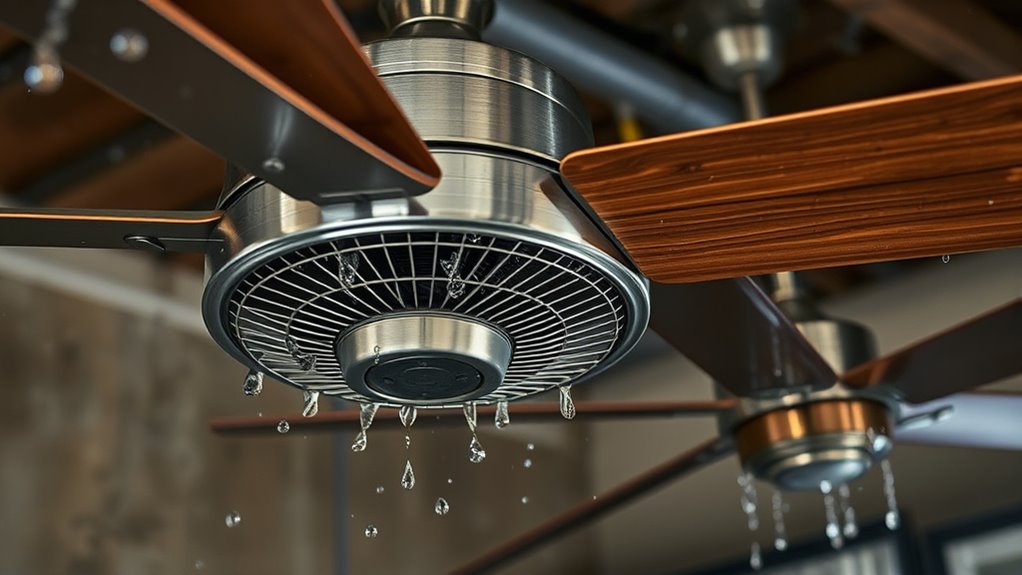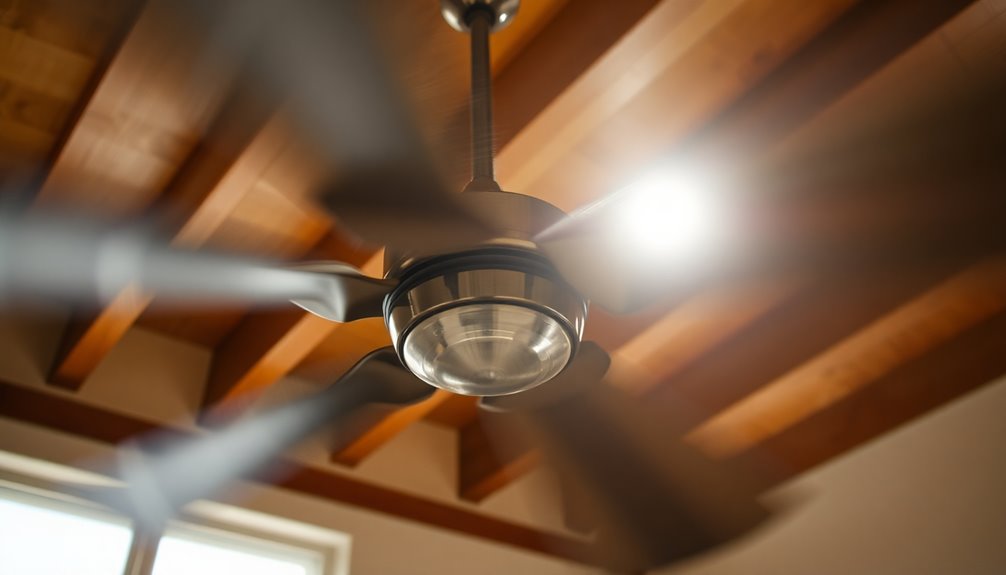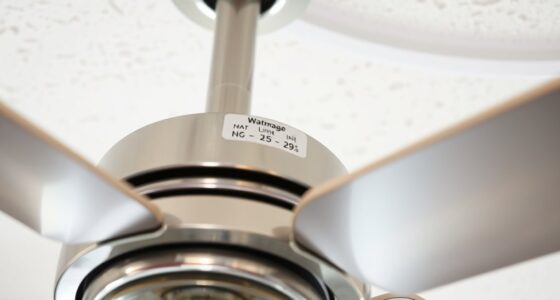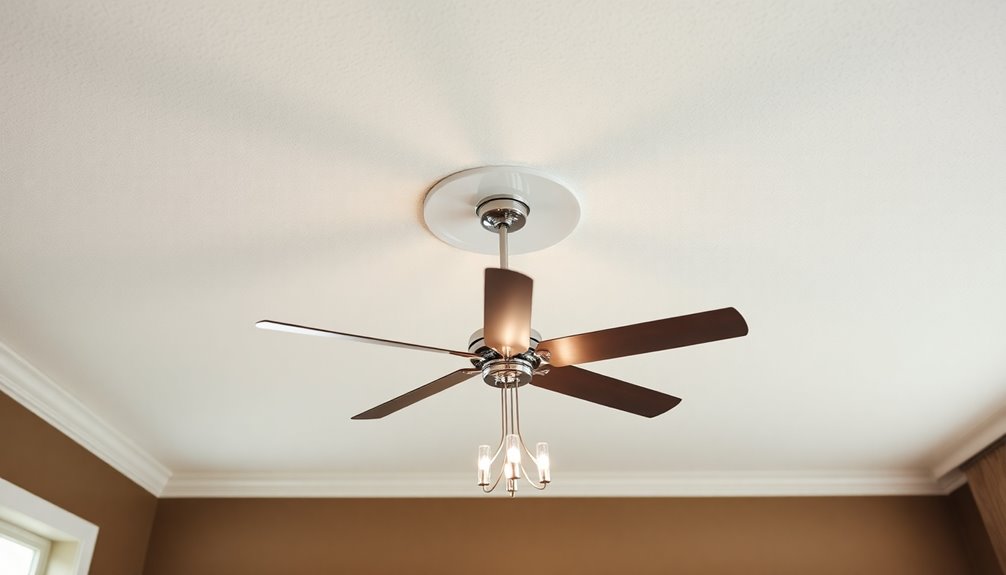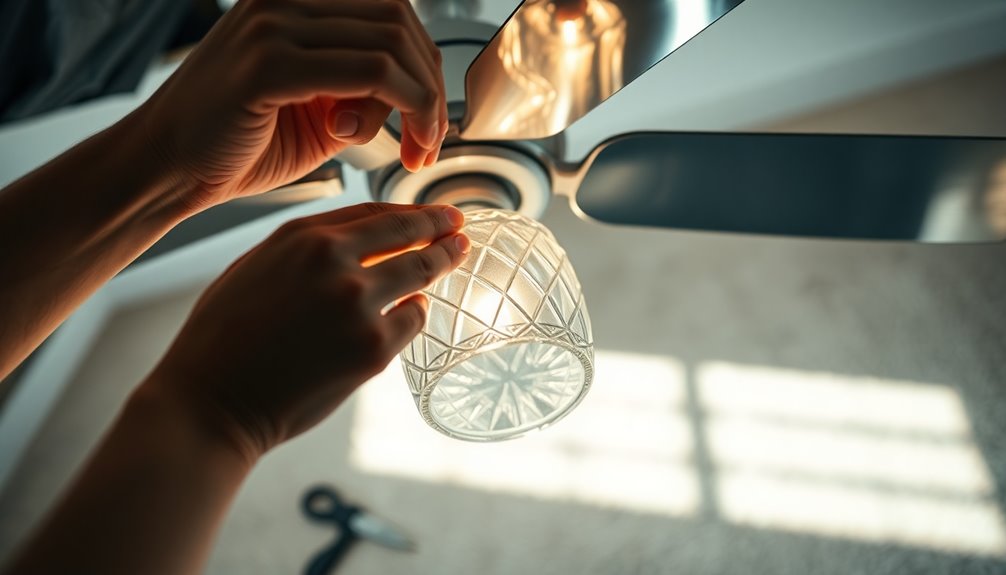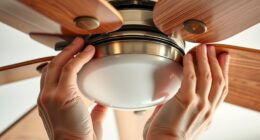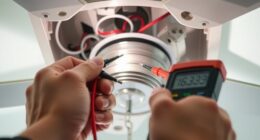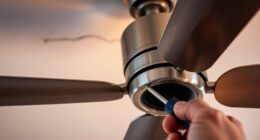UL damp and wet ratings tell you how well a fan resists moisture and water exposure. Damp-rated fans are suitable for areas with humidity or occasional splashes, like bathrooms or covered patios, but aren’t meant for direct water contact. Wet-rated fans are built to handle direct sprays and outdoor conditions, making them perfect for outdoor spaces or near pools. Understanding these ratings helps you pick the right fan. To discover more details, keep exploring the differences and applications.
Key Takeaways
- UL damp-rated fans are suitable for semi-enclosed, humid environments but not designed for direct water contact.
- UL wet-rated fans are built to withstand direct water exposure, making them ideal for outdoor and high-moisture areas.
- Wet-rated fans use corrosion-resistant and waterproof materials to prevent rust and deterioration over time.
- Proper rating selection ensures safety, compliance, and longevity based on the specific environment’s moisture and water exposure.
- Regular maintenance and correct installation are essential to maximize the performance and safety of both damp and wet-rated fans.
Understanding UL Ratings and Their Importance
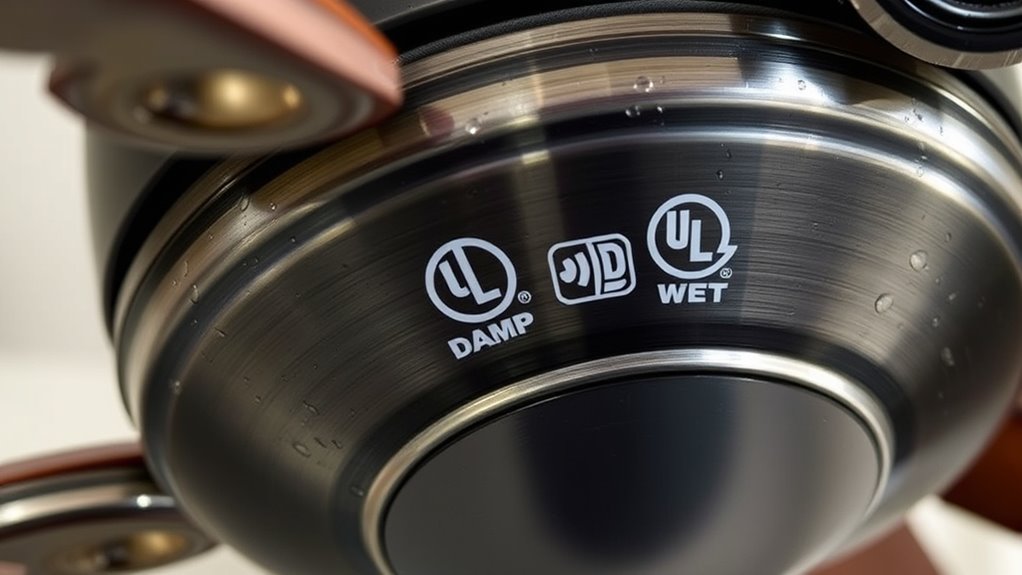
Understanding UL ratings is essential because they verify that fans meet safety and performance standards set by Underwriters Laboratories. These ratings help you determine if a fan is suitable for specific environments, especially when considering indoor air quality. A UL rating guarantees the fan is tested for durability and safety, reducing risks like electrical fires or malfunctions. Additionally, UL ratings influence fan efficiency, helping you choose models that operate effectively without wasting energy. Knowing the difference between UL Damp and Wet ratings allows you to select fans appropriate for the environment, ensuring ideal performance and safety. Ultimately, understanding UL ratings helps you make informed decisions, ensuring your space remains safe, well-ventilated, and energy-efficient.
What Does the UL Damp Rating Cover?

A UL Damp rating means your fan is protected against moisture and suitable for semi-enclosed or humid environments. However, it’s important to understand what types of exposure it can tolerate and what limitations exist. Proper care ensures the fan maintains its safety and performance over time. Additionally, understanding the scope of UL ratings can help you select the right fan for your specific environment, especially considering fire safety standards necessary for proper operation in various settings. Recognizing automation in business can also provide insight into how such technologies might influence future product safety testing and certification processes.
Protection From Moisture
The UL Damp rating guarantees that fans can withstand exposure to moisture without compromising safety or performance. This rating ensures your fan has sufficient moisture resistance to handle humid or damp environments. It’s designed for areas where occasional splashes or humidity are common, but direct water contact isn’t expected. The rating also speaks to the environmental durability of the fan’s components, meaning they won’t degrade quickly when exposed to moisture over time. If you plan to install a fan in a bathroom, laundry room, or covered outdoor space, a UL Damp-rated product offers peace of mind. It’s engineered to resist moisture infiltration, maintaining its safety standards and operational integrity despite environmental challenges. Additionally, research supports the use of UL Damp-rated fans in environments where moisture resistance influences performance, ensuring long-lasting functionality.
Suitable Environments
UL Damp-rated fans are designed to perform reliably in environments where moisture is present but not overwhelming. They are suitable for areas with moderate humidity, ensuring durability and consistent ventilation efficiency. These fans typically resist corrosion, making them ideal for spaces exposed to occasional splashes or humidity. Here are some suitable environments:
- Bathrooms and laundry rooms
- Covered patios and porches
- Commercial kitchens with controlled humidity
- Indoor pools and spa areas
- Vetted fans often feature corrosion-resistant materials to withstand moisture exposure over time.
- They are also equipped with corrosion resistance features that extend their lifespan in moist conditions. Durability in moist environments is crucial for maintaining performance over time.
In these settings, UL Damp-rated fans can handle moisture fluctuations without compromising performance. They maintain their corrosion resistance and ventilation efficiency over time, making them a smart choice for spaces where moisture is inevitable but not excessive.
Limitations and Care
While UL Damp ratings indicate that fans are suitable for environments with moderate moisture, they don’t guarantee protection against all types of water exposure. You must still exercise caution to maintain their corrosion resistance and airflow optimization. Avoid direct contact with water or high humidity levels that exceed the rating’s scope. Regularly inspect your fans for rust or corrosion, especially in humid settings. Proper care includes keeping vents clear and ensuring the fan’s enclosure remains intact. Additionally, understanding the contrast ratio can help assess the quality of images in your home cinema. Here’s a quick guide:
| Environment | Suitable Use | Care Tips |
|---|---|---|
| Bathroom | Ventilation, air circulation | Check for corrosion |
| Outdoor covered | Sheltered outdoor spaces | Protect from direct water |
| Kitchen | Fume extraction | Clean regularly |
| Basement | Moderate humidity, airflow | Inspect for rust |
| Garage | Light moisture, ventilation | Keep dry and well-maintained |
What Does the UL Wet Rating Cover?

The UL Wet Rating indicates that a fan can withstand direct water exposure without compromising safety or functionality. It covers specific protection standards that guarantee the product endures harsher conditions than those rated for damp environments. Understanding these water exposure levels helps you choose the right fan for outdoor or wet locations. This rating ensures safety by preventing potential electrical hazards when exposed to moisture. Additionally, the rating takes into account water resistance levels, ensuring the fan’s components remain protected during prolonged or intense water contact. Knowing the environmental conditions that the rating covers can help you select a fan suited for your specific outdoor or high-moisture setting.
Water Exposure Levels
Understanding what the UL Wet Rating covers helps you determine if a fan is suitable for outdoor or moisture-prone environments. This rating assesses how well a fan withstands water exposure, considering factors like rainfall, humidity, and direct splashes. With a UL Wet rating, your fan is designed using waterproof materials that resist environmental impacts, ensuring durability. Additionally, selecting a fan with the appropriate rust-resistant materials can further extend its lifespan in damp settings. Proper ventilation and moisture-resistant design are key components to ensure safety and longevity in wet environments. Knowing how celebrity lifestyle insights influence product durability can also help in choosing high-quality outdoor fans.
Protection Standards
Knowing what the UL Wet Rating covers is essential to guarantee your fan can withstand specific water exposure conditions. The protection standards focus on how well the fan material resists water intrusion and corrosion, ensuring durability in wet environments. A fan with a Wet Rating is tested against direct water contact, so it maintains ventilation efficiency without damage. These standards specify the degree of protection offered, such as resistance to splashes or immersion. By understanding these standards, you can select a fan that suits your needs, whether it’s for outdoor use or humid indoor spaces. Properly rated fans will keep functioning efficiently over time, safeguarding ventilation performance even when exposed to moisture or water exposure. Additionally, fans with appropriate water-resistant features can help prevent corrosion and extend the lifespan of the equipment in environments with high humidity or water contact, emphasizing the importance of protective coatings. Incorporating corrosion resistance into fan design further enhances their longevity in challenging conditions.
Key Differences Between Damp and Wet Ratings

While both damp and wet ratings indicate a fan’s ability to withstand moisture, they serve different purposes and environments. The key differences include:
- Protection level: Wet-rated fans are designed for direct exposure to water, making them suitable for outdoor or washdown areas, while damp-rated fans handle humidity control in covered spaces. They are often constructed with corrosion-resistant materials to ensure durability over time.
- Ingress protection: Wet ratings offer higher protection against water ingress, ensuring ventilation efficiency even during heavy rain or splashes.
- Installation sites: Damp-rated fans work well in bathrooms or kitchens, where moisture is present but not direct contact, whereas wet-rated fans are ideal for outdoor patios or pools.
- Durability: Wet-rated fans tend to be more durable against constant moisture, providing long-term reliability for moisture-heavy environments.
- Material construction: Wet-rated fans typically utilize corrosion-resistant materials to withstand prolonged exposure to moisture, enhancing their longevity in moisture-heavy environments.
Factors to Consider When Choosing a Fan Based on Ratings
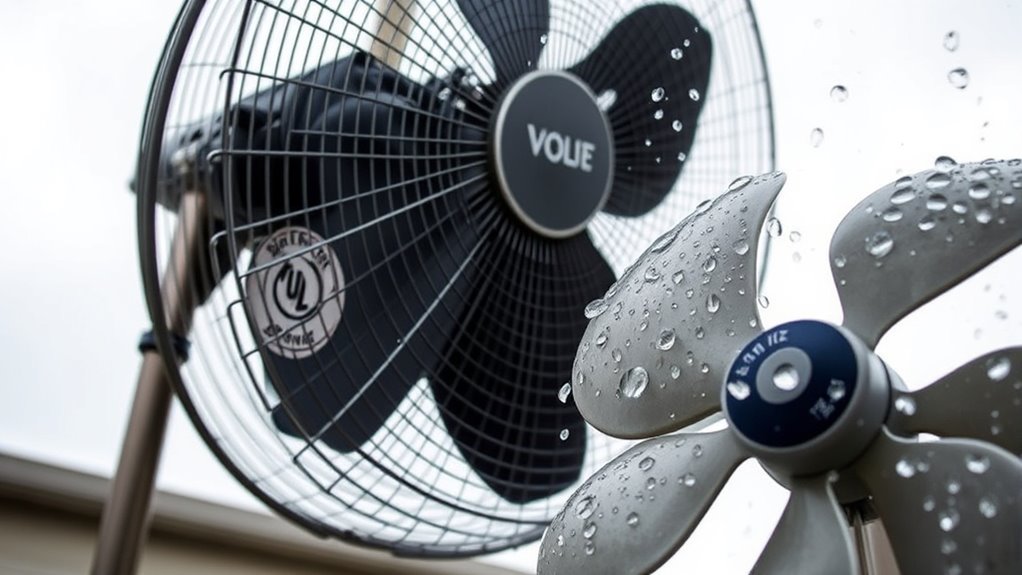
Choosing the right fan rating depends on evaluating your specific environment and moisture exposure. Consider the ventilation standards relevant to your space, guaranteeing the fan meets safety and performance requirements. Assess your environmental conditions—if the area experiences frequent humidity, splashes, or direct contact with water, a wet-rated fan is essential. For spaces with moderate moisture or indirect exposure, a damp-rated fan may suffice. Think about airflow needs and durability; wet-rated fans are built to withstand harsher conditions, while damp-rated fans are suitable for more controlled environments. Always verify that the fan’s UL rating aligns with the environmental conditions it’ll face. Proper selection ensures safety, longevity, and ideal ventilation performance in your space. Additionally, understanding the cycle of breakups can help in managing emotional stress during installation or maintenance in sensitive environments.
Common Applications for Damp and Wet Rated Fans

Damp and wet rated fans are designed for specific environments where moisture is a concern, making them ideal for various applications. You’ll find these fans fulfilling ventilation requirements in areas exposed to humidity, rain, or splashes, while maintaining corrosion resistance. Here are some common uses:
- Outdoor patios and covered spaces – handle weather exposure and ensure proper airflow.
- Bathrooms and laundry rooms – combat humidity and prevent mold growth.
- Commercial kitchens – resist moisture from splashes and steam.
- Parking garages – withstand rain, humidity, and corrosive elements.
These fans are built to perform reliably in environments where moisture can compromise standard fans, helping you maintain safe, efficient ventilation while preventing corrosion. Their durability makes them essential for many moist or wet environments.
How Ratings Affect Fan Durability and Safety
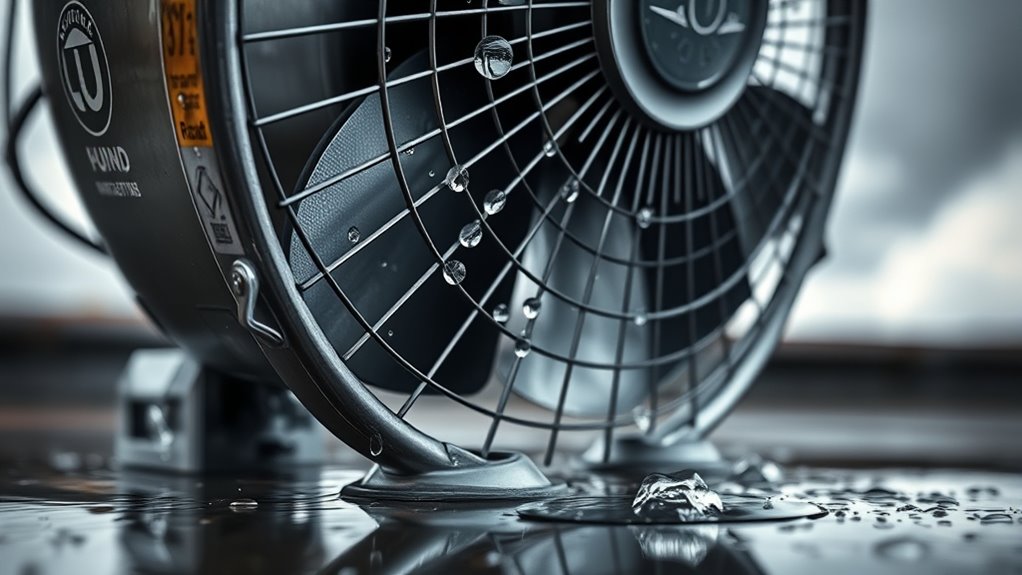
Ratings like UL Damp and Wet labels directly influence how long a fan will last in moisture-prone environments. These ratings guarantee your fan has proper corrosion resistance, preventing rust and deterioration that can compromise safety and performance. A fan with a UL Wet rating is designed to withstand direct contact with water, making it more durable over time. This durability also helps maintain airflow efficiency, ensuring the fan operates effectively without frequent replacements. In contrast, a fan without the appropriate rating may corrode quickly, reducing its lifespan and risking safety hazards like electrical shorts or mechanical failures. Choosing the correct rating helps you invest in a fan that lasts longer, performs reliably, and keeps your environment safe from moisture-related issues.
Tips for Proper Installation and Maintenance of Rated Fans
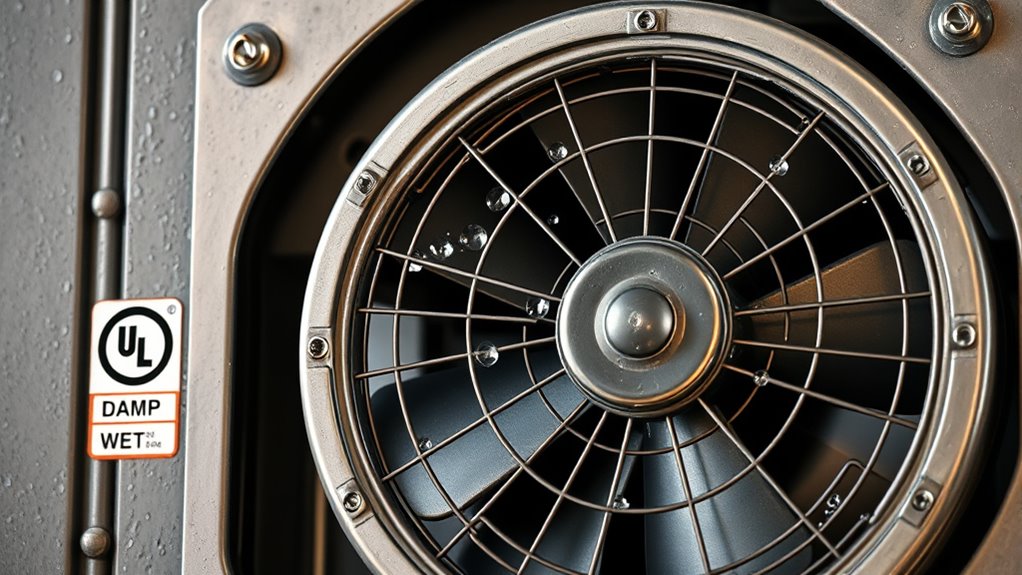
To guarantee your rated fan performs reliably and lasts as long as possible, proper installation and regular maintenance are essential. Start with the right fan material—choose corrosion-resistant options like stainless steel or plastic for damp or wet environments. Follow these installation tips:
- Ensure the fan is mounted securely on a stable surface.
- Verify the electrical connections match the fan’s specifications.
- Maintain proper clearance around the fan for airflow.
- Regularly inspect for debris, corrosion, or wear.
Proper installation prevents damage, while routine maintenance extends the fan’s lifespan. Clean blades, check wiring, and replace any worn parts promptly. By paying attention to installation tips and selecting the correct fan material, you’ll guarantee peak performance and safety over time.
Frequently Asked Questions
Can a Damp-Rated Fan Be Used Outdoors Safely?
A damp-rated fan can be used outdoors safely if it’s installed in a covered area, ensuring indoor safety and protecting it from direct weather exposure. While it offers energy efficiency and suits outdoor spaces, avoid using it in open or wet conditions. Always check the UL damp rating to confirm suitability. This way, you enjoy outdoor comfort while maintaining safety and energy efficiency in your fan choice.
Are Wet-Rated Fans Suitable for Swimming Pool Areas?
You should not use wet-rated fans in swimming pool areas because they’re designed for high moisture environments and offer superior corrosion resistance. These fans can handle direct exposure to water, making them suitable for such outdoor spaces. Just guarantee you follow installation guidelines closely, including proper placement and sealing, to prevent water intrusion and maintain safety. Using the right fan rating ensures durability and safe operation around pools.
How Do UL Ratings Impact Fan Warranty Coverage?
Think of UL certification as a seal of trust, guiding your decision on warranty coverage. When your fan bears UL ratings, it signals that the product meets safety standards, which often influences warranty terms. Without this certification, coverage might be limited or void. So, choosing UL-certified fans guarantees better warranty protection, giving you peace of mind knowing your investment is safeguarded by rigorous safety and quality standards.
Are There Specific Brands Known for Reliable Damp and Wet Rated Fans?
When choosing damp or wet-rated fans, you should consider brand reputation and certification standards. Some brands consistently meet high quality and safety benchmarks, making them more reliable for outdoor or humid environments. Look for certifications like UL, which ensure the fans adhere to strict standards. Well-known brands often have better durability and performance, giving you peace of mind that your investment will last and operate safely in demanding conditions.
What Maintenance Precautions Are Necessary for Rated Fans in Harsh Environments?
In harsh environments, you need to prioritize corrosion resistance and electrical safety for rated fans. Regularly inspect for corrosion buildup and clean fan components to prevent rust. Guarantee electrical connections stay secure and dry to avoid shorts or malfunctions. Keep vents clear for proper airflow, and follow manufacturer guidelines for maintenance intervals. These precautions help maintain performance, extend fan lifespan, and ensure safety in challenging conditions.
Conclusion
Knowing the difference between UL damp and wet ratings helps you choose the right fan for your space, ensuring safety and longevity. Did you know that improperly rated fans can fail within just a year, costing you more in repairs? By understanding these ratings, you can make smarter decisions, protect your investment, and enjoy reliable performance. Always consider your environment and follow proper installation tips to maximize your fan’s lifespan and safety.
